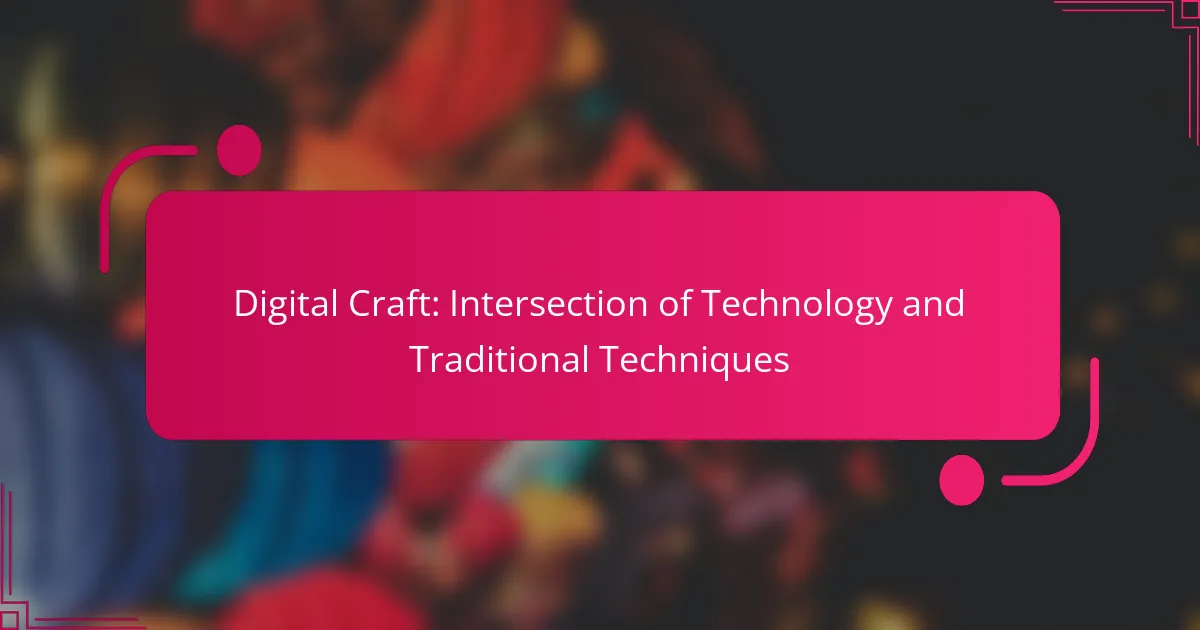Digital craft enhances creativity and efficiency by merging advanced technology with traditional techniques. This article explores the benefits and challenges of this integration, emerging applications like augmented reality and 3D printing, the importance of community support, and effective marketing strategies for creators. Understanding these elements can help artisans navigate the evolving landscape of digital craftsmanship.
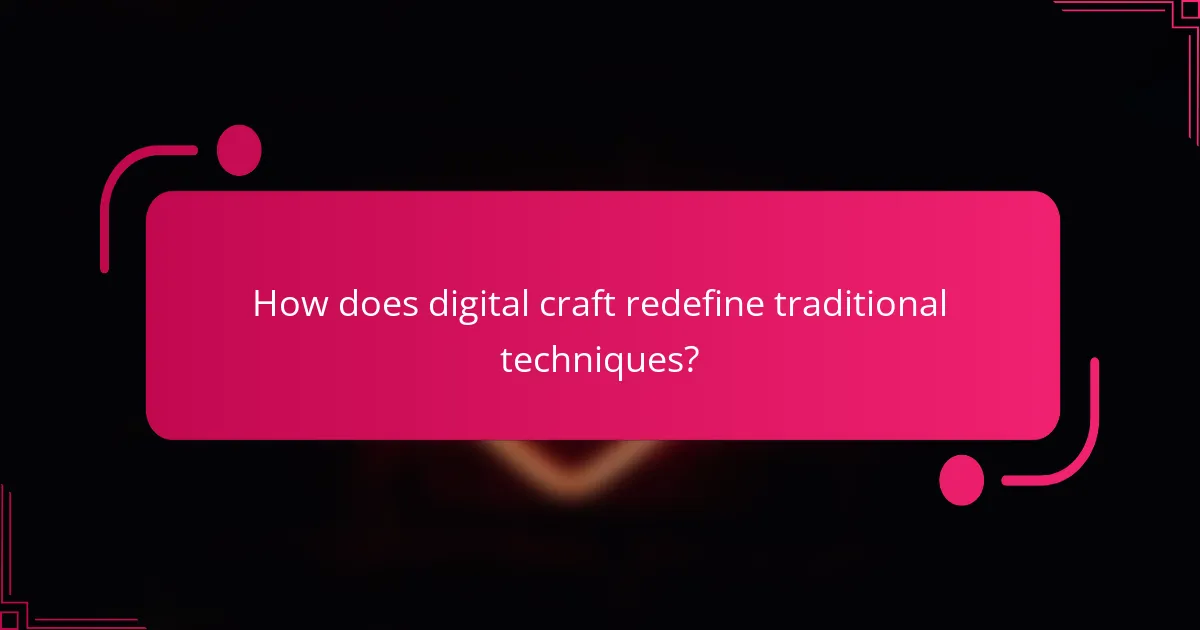
How does digital craft redefine traditional techniques?
Digital craft redefines traditional techniques by integrating advanced technology, enhancing creativity and efficiency. This fusion allows artisans to explore innovative designs and precision that were previously unattainable. For instance, 3D printing enables complex structures, transforming conventional craftsmanship. As a result, digital craft not only preserves heritage but also expands its possibilities.
What are the key technologies driving the digital craft movement?
Key technologies driving the digital craft movement include 3D printing, augmented reality, and digital fabrication tools. These technologies enhance traditional crafting methods, allowing artisans to create intricate designs with precision.
3D printing revolutionizes prototyping and production, enabling rapid iteration and customization. Augmented reality enhances the design process, allowing creators to visualize and manipulate their work in a digital space. Digital fabrication tools streamline production, merging software design with physical creation.
Together, these technologies foster innovation and accessibility in the craft community, bridging the gap between digital and traditional techniques.
Which traditional techniques are most commonly integrated with digital methods?
Traditional techniques commonly integrated with digital methods include hand-drawing, weaving, pottery, woodworking, and printmaking. These practices enhance digital craft by adding texture, authenticity, and cultural significance. For example, artists combine digital design software with traditional sketching to create unique visual narratives. This fusion allows for innovative expressions while preserving age-old techniques.
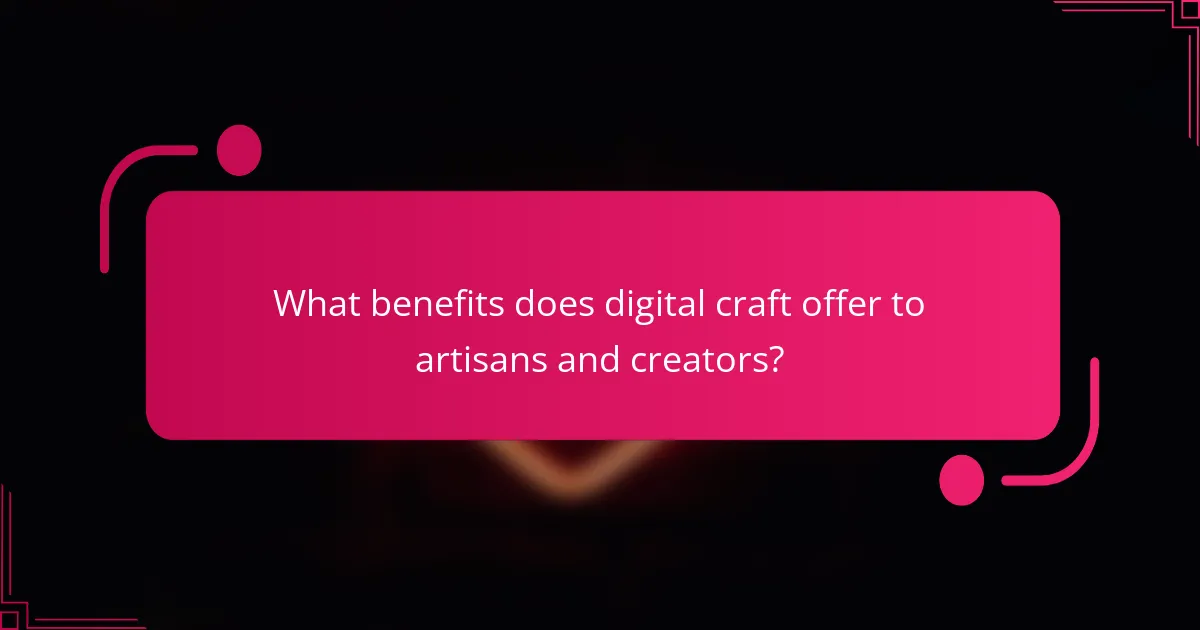
What benefits does digital craft offer to artisans and creators?
Digital craft offers artisans and creators enhanced creativity, efficiency, and market reach. It merges technology with traditional techniques, allowing for innovative designs and streamlined production processes. Digital tools enable precise customization and reduce material waste, fostering sustainability. Additionally, online platforms provide global exposure, increasing sales opportunities for creators.
How does digital craft enhance creativity and innovation?
Digital craft enhances creativity and innovation by merging technology with traditional techniques. This integration allows artists and creators to explore new mediums and methods, resulting in unique expressions and solutions.
Digital tools enable rapid prototyping, which fosters experimentation. For instance, 3D printing allows for immediate adjustments in design, encouraging iterative creativity. Additionally, software programs provide access to vast libraries of resources, inspiring new ideas and approaches.
The unique attribute of digital craft lies in its ability to democratize access to creative tools. Many platforms offer free or affordable resources, empowering individuals regardless of their background. This inclusivity leads to a broader range of perspectives and innovations.
As a result, digital craft not only enhances personal creativity but also drives collective innovation across various industries, from art to technology.
In what ways does digital craft improve accessibility for artists?
Digital craft enhances accessibility for artists by leveraging technology to bridge gaps in traditional techniques. It enables artists to create and share work globally, regardless of physical location or resources. Digital tools allow for diverse forms of expression, catering to various skill levels and disabilities. For instance, software can provide adaptive features, making art creation more inclusive. Additionally, online platforms facilitate collaboration and exposure, fostering a supportive community for emerging artists.
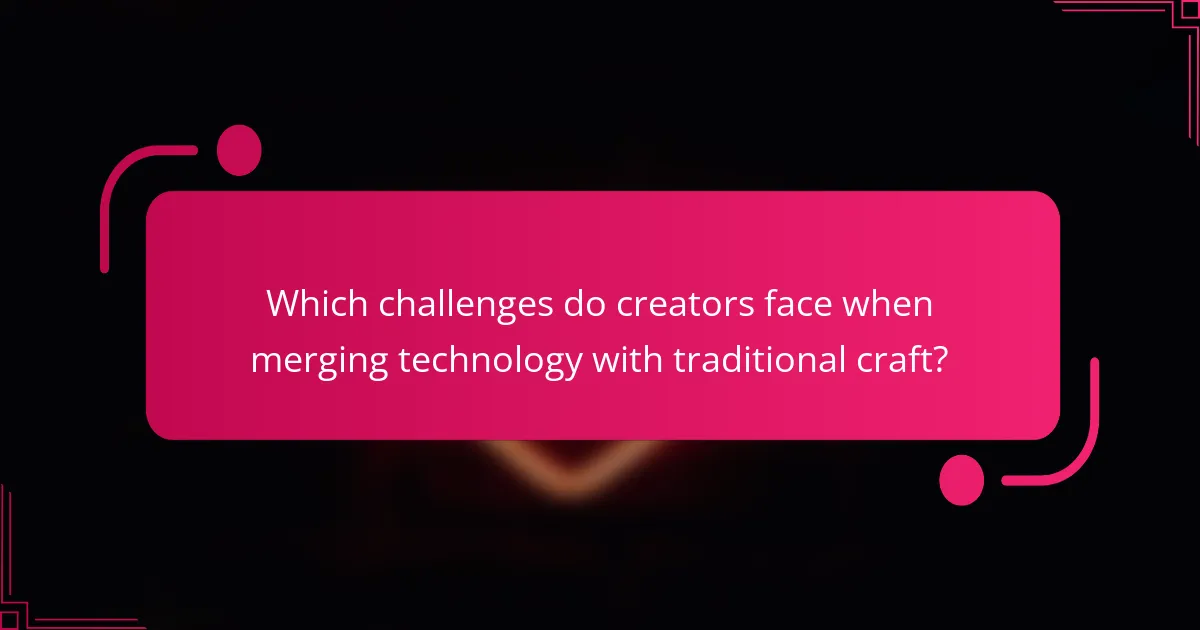
Which challenges do creators face when merging technology with traditional craft?
Creators face several challenges when merging technology with traditional craft. These include balancing authenticity with innovation, mastering new tools, and addressing market demand for both handmade and digital products.
Authenticity can be compromised as technology often alters traditional techniques. For example, digital fabrication may produce items that lack the unique imperfections of handcrafting. Mastering technology requires time and effort, diverting focus from traditional skills.
Market demand fluctuates, with some consumers preferring traditional craftsmanship while others embrace digital innovation. This creates tension for creators trying to cater to both audiences.
Additionally, there are financial barriers, such as the cost of technology and software, which can hinder access for some artisans. Overall, navigating these challenges requires adaptability and a clear vision of the desired outcome.
What are the common technical barriers to entry in digital craft?
Common technical barriers to entry in digital craft include high initial costs, lack of technical skills, and limited access to advanced tools. These barriers can hinder creativity and innovation in merging technology with traditional techniques.
High initial costs often deter newcomers from investing in necessary software and hardware. Lack of technical skills can prevent artisans from fully utilizing digital tools, limiting their ability to create complex designs. Limited access to advanced tools restricts experimentation and learning, making it difficult to stay competitive.
Addressing these barriers requires targeted education, community support, and accessible resources to foster a thriving digital craft environment.
How do cultural perceptions influence the adoption of digital craft?
Cultural perceptions significantly shape the adoption of digital craft. Different societies view technology and traditional methods uniquely, influencing how digital craft is embraced.
In cultures that value innovation, digital craft often thrives, merging traditional techniques with modern technology. Conversely, cultures emphasizing heritage may resist digital methods, fearing loss of authenticity.
For example, in Japan, artisans blend digital tools with centuries-old practices, enhancing craftsmanship while preserving cultural identity. In contrast, some indigenous communities may prioritize traditional techniques, viewing digital craft as a threat to their heritage.
As a result, understanding these cultural contexts is crucial for promoting digital craft effectively, ensuring respect for traditions while encouraging technological integration.
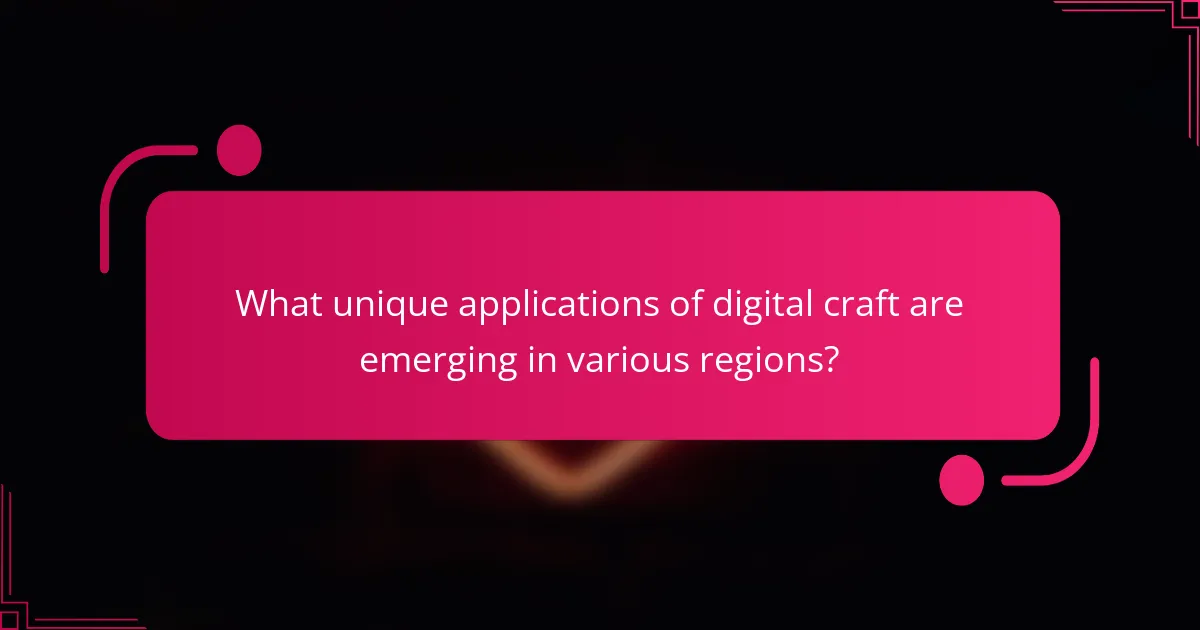
What unique applications of digital craft are emerging in various regions?
Emerging applications of digital craft include augmented reality in traditional art, 3D printing for custom designs, and blockchain for provenance tracking. Regions like Europe and Asia are leading in integrating these technologies with local crafts. For example, artisans in Japan use AR to enhance cultural storytelling, while European makers leverage 3D printing for sustainable materials. These innovations not only preserve heritage but also attract younger audiences.
How are local artisans in North America leveraging digital tools?
Local artisans in North America are leveraging digital tools to enhance their craft and reach wider audiences. They utilize e-commerce platforms to sell handmade goods, social media for marketing, and digital design software for product development. These tools enable artisans to blend traditional techniques with modern technology, improving efficiency and creativity. As a result, artisans can showcase their unique attributes and connect with customers globally, driving growth in the local craft economy.
What are the notable trends in Europe regarding digital craft practices?
Notable trends in Europe regarding digital craft practices include the integration of augmented reality in traditional craftsmanship, the rise of online platforms for artisans, and a focus on sustainability through digital tools. Artisans increasingly blend technology with heritage techniques, fostering innovation. Collaborative projects among creatives and tech experts enhance skill-sharing and community engagement. Additionally, educational programs are adapting to incorporate digital skills, ensuring future artisans are equipped for modern demands.
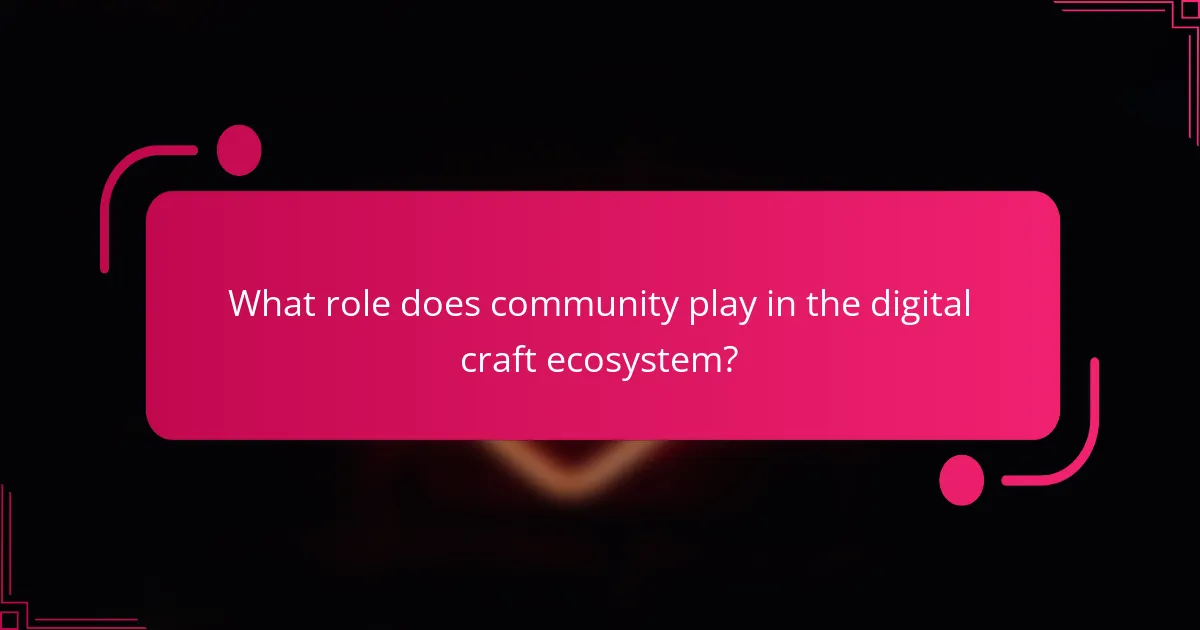
What role does community play in the digital craft ecosystem?
Community plays a crucial role in the digital craft ecosystem by fostering collaboration and knowledge sharing. It connects individuals who blend technology with traditional techniques, enhancing creativity and innovation. Community support encourages skill development and resource sharing, which are vital for growth. Furthermore, it cultivates a sense of belonging, motivating creators to explore new ideas and push boundaries in their craft.
How do online platforms facilitate collaboration among creators?
Online platforms enhance collaboration among creators by providing tools for communication, project management, and resource sharing. These platforms enable real-time feedback, fostering creativity and innovation. Features like file sharing, video conferencing, and collaborative editing streamline workflows. Additionally, communities on these platforms offer networking opportunities, connecting creators with diverse skills and perspectives. This intersection of technology and traditional techniques empowers creators to blend their expertise effectively.
What are the benefits of participating in digital craft communities?
Participating in digital craft communities enhances creativity, skill development, and networking opportunities. These communities provide access to diverse techniques and resources, fostering collaboration and innovation. Members often share valuable feedback and inspiration, leading to personal growth and improved craftsmanship. Engaging in these spaces can also connect artisans with potential clients and collaborators, expanding their reach and influence in the craft world.
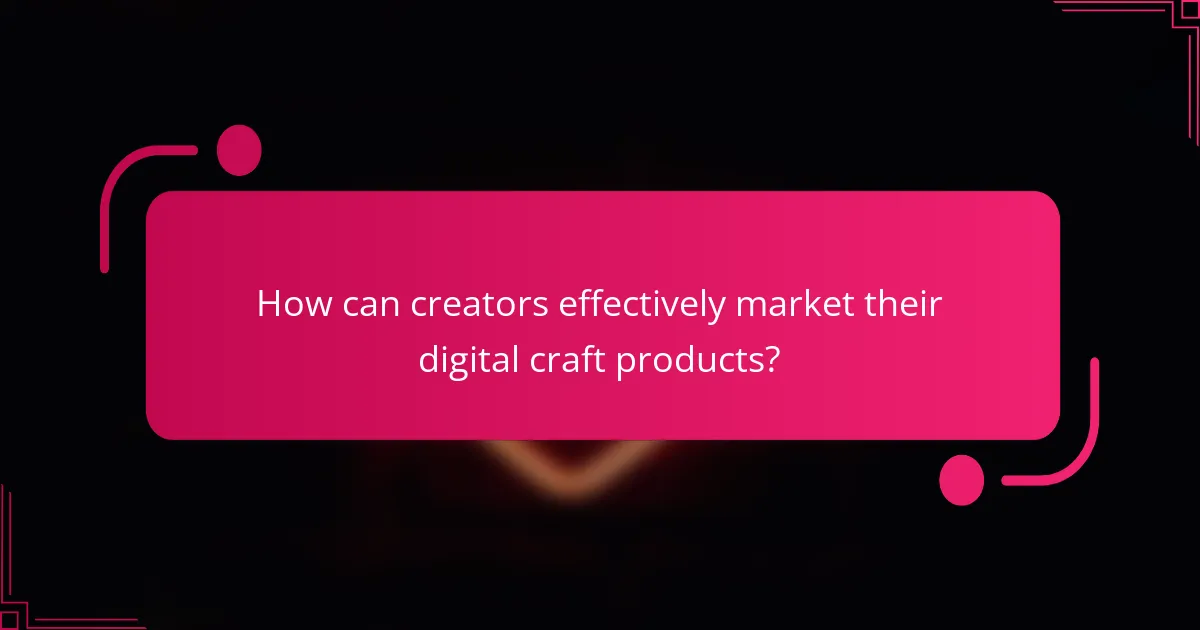
How can creators effectively market their digital craft products?
Creators can effectively market their digital craft products by leveraging social media, engaging with niche communities, and utilizing SEO strategies. Social media platforms allow creators to showcase their work visually, attracting potential customers. Engaging with niche communities fosters connections and builds a loyal audience. Implementing SEO strategies enhances online visibility, driving organic traffic to their product listings.
Additionally, offering exclusive promotions or limited-time products can create urgency and encourage purchases. Collaborating with influencers in the craft space can also amplify reach and credibility. By combining these strategies, creators can effectively position their digital craft products in a competitive market.
What strategies work best for promoting digital craft on social media?
Engaging storytelling and visual content are the best strategies for promoting digital craft on social media. Highlight the fusion of technology and traditional techniques through captivating narratives. Utilize high-quality images and videos to showcase the creation process, emphasizing unique attributes like craftsmanship and innovation. Collaborate with influencers in the craft community to expand reach and credibility. Encourage user-generated content by hosting challenges or contests, fostering a sense of community and participation. Regularly analyze engagement metrics to refine strategies and enhance audience connection.
Which online marketplaces are ideal for selling digital craft items?
Etsy, Creative Market, and Redbubble are ideal online marketplaces for selling digital craft items. These platforms cater specifically to creators, offering a user-friendly interface and a targeted audience.
Etsy focuses on handmade and vintage items, making it perfect for digital crafts that emphasize creativity. Creative Market specializes in design assets, allowing sellers to reach graphic designers and marketers. Redbubble provides a platform for artists to sell their designs on various products, expanding market reach.
Each marketplace has unique attributes: Etsy charges listing fees, Creative Market takes a commission on sales, and Redbubble handles production and shipping. These features cater to different business models and seller preferences.
Choosing the right marketplace depends on your target audience and the nature of your digital crafts. Evaluate each platform’s benefits to maximize your sales potential.
What are the best practices for showcasing digital craft portfolios?
To effectively showcase digital craft portfolios, emphasize a blend of technology and traditional techniques. Highlight unique projects that demonstrate creativity, technical skills, and craftsmanship. Use high-quality visuals and concise descriptions to engage viewers. Consider including case studies that outline the process and challenges faced, showcasing problem-solving abilities. Regularly update the portfolio to reflect recent work and maintain relevance in the evolving digital landscape.
What common mistakes should artisans avoid in the digital craft space?
Artisans should avoid common mistakes such as neglecting online presence, underpricing their work, and failing to understand their target audience. Prioritizing technology over craftsmanship can diminish quality, while inconsistent branding may confuse potential customers. Additionally, not engaging with the digital community limits exposure and growth.
How can creators optimize their workflow in digital craft projects?
Creators can optimize their workflow in digital craft projects by integrating technology with traditional techniques. Streamlining processes enhances efficiency and creativity.
Utilize digital tools for project management, enabling better collaboration and task tracking. Software like Trello or Asana organizes tasks and deadlines effectively.
Incorporate design software for precise execution of craft ideas. Programs such as Adobe Illustrator or Procreate allow for detailed digital illustrations and designs.
Adopt automation tools to reduce repetitive tasks. Using scripts or software like Zapier can save time on mundane activities, allowing more focus on creativity.
